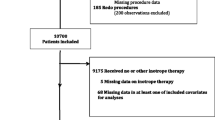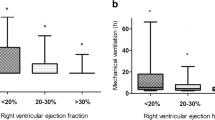Abstract
We assessed the effect of milrinone on myocardial function in pediatric patients with postoperative low cardiac output syndrome by index of myocardial performance in a prospective, open-label, nonrandomized, consecutive study. Fifteen patients with low cardiac output syndrome following cardiac surgical treatment were studied in the tertiary cardiothoracic pediatric intensive care unit between April 2001 and November 2003 (age range, 0.2–16 months; median, 7; weight, 2.7–11.8 kg; median, 5). Echocardiographic, Doppler-derived, time interval-based index of myocardial performance (Tei index) was used to study cardiac function prior to and while on intravenous milrinone treatment for 18–24 hours. Treatment with milrinone led to improvement in biventricular myocardial function [mean right ventricular index from 0.521 (SD-0.213) to 0.385 (SD-0.215), p = 0.003; mean left ventricular index from 0.636 (SD-0.209) to 0.5 (SD-0.171), p = 0.012). No difference was found in the values of heart rate corrected right or left ventricular ejection time prior to and while on treatment with milrinone (right ventricle: mean, 1.23 (SD-0.42) and 1.14 (SD-0.48), p = 0.29; left ventricles: mean, 1.17 (SD-0.51) and 1.13 (SD-0.48), p = 0.66) Our data support the direct myocardial effect of milrinone as part of the mechanism behind its already proven benefit in children with low cardiac output syndrome following cardiac surgery.
Similar content being viewed by others
References
ABPI Compendium of Data Sheets and Summaries of Product Characteristics 1999–2000 (1999). Datapharm, London, p 1419
Barton P, sGarcia J, Kouatli A, et al. (1996) Hemodynamic effects of IV milrinone lactate in pediatric patients with septic shock. A prospective, double-blinded, randomized, placebo-controlled, interventional study. Chest 109:1302–1312
Chanani NK, Cowan DB, Takeuchi K, et al (2002) Differential effects of amrinone and milrinone upon myocardial inflammatory signaling. Circulation 106 (Suppl 1):284–289
Chang AC, Atz AM, Wernovsky G, Burke RP, Wessel DL (1995) Milrinone: systemic and pulmonary hemodynamic effects in neonates after cardiac surgery. Grit Care Med 23:1907–1914
Chatterjee K (1989) Phosphodiesterase inhibitors: alterations in systemic and coronary hemodynamics. Basic Res Cardiol 84 (Suppl 1):213–224
Eidem BW, O’Leary PW, Tei C, Seward JB (2000) Usefulness of the myocardial performance index in assessing right ventricular function in congenital heart disease. Am J Cardiol 86:654–658
Eidem BW, Tei C, O’Leary PW, Cetta F, Seward JB (1998) Nongeometric quantitative assessment of right and left ventricular function: myocardial performance index in normal children and patients with Ebstein’s anomaly. J Am Soc Echocardiogr 11:849–856
Hiramatsu N, Kageyama K (2003) Anti-thrombotic effect of milrinone is caused by inhibition of calcium release from the dense tubular system in human platelets. Acta Anaesthesiol Scand 47:53–57
Hoffman TM, Wernovsky G, Atz AM, et al. (2003) Efficacy and safety of milrinone in preventing low cardiac output syndrome in infants and children after corrective surgery for congenital heart disease. Circulation 107:996–1002
Holmberg SR, Williams AJ (1991) Phosphodiesterase inhibitors and the cardiac sarcoplasmic reticulum calcium release channel: differential effects of milrinone and enoximone. Cardiovasc Res 25:537–545
Ishii M, Eto G, Tei C, et al. (2000) Quantitation of global right ventricular function in children with normal heart and congenital heart disease: a right ventricular myocardial performance index. Pediatr-Cardiol 21:416–421
Katz AM (1990) Interplay between inotropic and lusitropic effects of cyclic adenosine monophosphate on the myocardial cell. Circulation 82 (Suppl 2):7–11
Kauffman RF, Schenk KW, Utterback BG, Crowe VG, Cohen ML (1987) In vitro vascular relaxation by new inotropic agents: relationship to phospfiodiesterase inhibition and cyclic nucleotides. J Pharmacol Exp Ther 242:864–872
Kumar A, Kosuri R, Kandula P, et al. (1999) Effects of epinephrine and amrinone on contractility and cyclic adenosine monophospahte generation of tumor necrosis factor alpha-exposed cardiac myocytes. Crit Care Med 27:286–292
LaCorte JC, Cabreriza SE, Rabkin DG, et al (2003) Correlation of Tei index with invasive measurements of ventricular function in porcine model. J Am Sosc Echocardiogr 16:442–447
Libonati JR, Ciccolo J, Glassber GH (2001) The Tei index and exercise capacity. J Sports Med Phys Fitness 41:108–113
Parr GVS, Blackstone EH, Kirklin JW (1975) Cardiac performance and mortality early after intracardiac surgery in infants and young children. Circulation 51:867–874
Polla B, Capelli V, Canepari M, Zanardi MC, Reggiani C (1995) Direct depressant effect of phosphodiesterase inhibitors on ATPase activity of cardiac myofibrils. Can J Physiol Pharmacol 73:661–664
Ravishankar C, Tabbutt S, Wernovsky G (2003) Critical care in cardiovacsular medicine. Curr Opin Pediatr 15:443–453
Ringe HIG, Varnholt V, Gaedicke G (2003) Cardiac rescue with enoximone in volume and catecholamine refractory septic shock. Pediatr Grit Care Med 4:471–475
Saatvedt K, Lindberg H, Michelsen S, et al. (1996) Release of soluble tumor necrosis factor alpha receptors during and after cardiopulmonary bypass. Correlation with haemodynamic and clinical variables. Cytokine 8:944–948
Tei C (1995) New non-invasive index for combined systolic and diastolic ventricular function. J Cardiol 26:135–136
Ted C, Dujardin KS, Hodge DO, et al (1996) Doppler echocardiographic index of global right ventricular function. J Am Soc Echocardiogr 9:838–847
Tei C, Nishimura RA, Seward JB, Tajik AJ (1997) Noninvasive Doppler-derived myocardial performance index correlation with simultaneous measurements of cardiac catheterisation measurements. J Am Soc Echocardiogr 10:169–178
Wernovsky G, Wypij D, Jonas RA, et al (1995) Postoperative course and hemodynamic profile after the arterial switch operation in neonates and infants. A comparison of low-floow cardiopulmonary bypass and circulatory arrest. Circulation 92:2226–2235
Author information
Authors and Affiliations
Corresponding author
Rights and permissions
About this article
Cite this article
Duggal, B., Pratap, U., Slavik, Z. et al. Milrinone and Low Cardiac Output Following Cardiac Surgery in Infants: Is There a Direct Myocardial Effect?. Pediatr Cardiol 26, 642–645 (2005). https://doi.org/10.1007/s00246-005-0881-z
Published:
Issue Date:
DOI: https://doi.org/10.1007/s00246-005-0881-z




